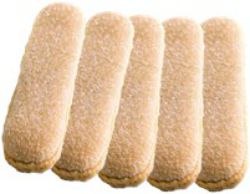Ladyfinger Cakes

Ladyfingers Cakes are oval-shaped cookies or cakes that are also known around the world as Boudoir biscuits, sponge biscuits, sponge fingers, Naples biscuits, Savoy biscuits (Savoiardi) and biscuits a la cuiller.
These are basically a very delicate sponge-style cake that is dry, egg-based, and sweet sponge biscuits roughly shaped like a large finger. They are called lady fingers because of their shape as they resemble the thin delicate fingers of a woman. Ladyfinger Cakes are a delicacy considered to be one of the rarest of bakers’ arts. They were introduced in America with the earliest French settlers. The dainty cakes are used extensively as an ingredient for elaborate French and Italian desserts.
11th Century – The recipe, which has changed little in nine hundred years, dates from the House of Savoy in the eleventh century France. Historians seem to think that the recipe was carried throughout Europe by the marriages of the descendents of Bertha of Savoy (1051-1081) to the royalty of Europe.
18th Century – Folklore has it that Czar Peter the Great of Russia (1689-1725) and his wife, the peasant empress Catherine, so enjoyed Ladyfingers when visiting Louis XV of France, that they purchased the Baker and sent him immediately to Saint Petersburg.
1901 – Specialty Bakers Inc., a small bakery company on the banks of the Susquehanna River in Marysville, Pennsylvania, is known as “The Ladyfinger Specialist.” Virtually all the commercially available Ladyfingers in America have been baked by Specialty Bakers since 1901.
Categories:
Food History